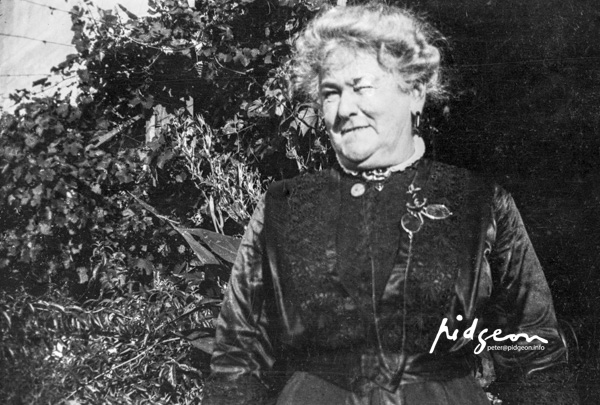
[19 September 1924]
WHITE .—The Relatives and Friends of Mr. JOHN WHITE, Master Builder, are kindly invited to attend the Funeral of his late beloved WIFE, Isabella Garrick, which will leave her late residence, “Trelawny”, Gurner-street, Paddington, THIS FRIDAY, at 3 p.m., for the Church of England Cemetery, Waverley.
CHARLES KINSELA, Funeral Director,
‘Phone, Padd. 694., 143 Oxford-street. Sydney.
WHITE.—The Relatives and Friends of Mr. and Mrs. JOHN A. WHITE, EDWARD C. WHITE, HARRY F. WHITE, Mrs. T. J. PIDGEON, Mr. and Mrs. S. E. PATERSON are kindly invited to attend the Funeral of their late beloved MOTHER,- Isabella Garrick Whlte, which will leave her late residence, Trelawny, Gurner street, Paddington, THIS FRIDAY, at 3 p.m., for Church of England Cemetery, Waverley.
WHITE.—The Relatives and Friends of Mr. D. MCRITCHIE, Mr. ROBERT MCRITCHIE, Mrs. R. THEW, Mrs. F. CROWE, Mrs. J. MCRITCHIE, Mr. and Mrs. McLEAN, Mr. and Mrs. E. CARR. Mr. and Mrs. CAMEREAUX, Mr. ROBERT MACKEY, and Mr. JAMES MACKEY are kindly invited to attend the Funeral of their late beloved SISTER and AUNT, Isabella Garrick White, which will leave her late residence, Trelawny, Gurner-street, Paddington, THIS FRIDAY, at 3 p.m., for the Church of England Cemetery, Waverley.
Family Notices (1924, September 19). The Sydney Morning Herald (NSW : 1842 – 1954), p. 7. Retrieved February 6, 2023, from http://nla.gov.au/nla.news-article16160237
WHITE.— September 18, 1924, at her late residence, “Trelawny,” Gurner Street, Paddington. Isabella Garrlck, dearly beloved wife of John White, and mother of William, Frederick, Thlrza, John, Edward, Harry, Percy, Isabella, and Blanche, aged 71 years.
Family Notices (1924, September 19). The Daily Telegraph (Sydney, NSW : 1883 – 1930), p. 6. Retrieved February 6, 2023, from http://nla.gov.au/nla.news-article245208210
Grandma was dead. It must have been in the morning sometime in December [sic] because I was given some money to go to the pantomime down at Tivoli. What the pantomime was about, or its name and its impact on me remains securely forgotten, rotting away in some remote and atrophied cell of the brain.
Amy Rochelle could have been the Principal Boy. Principal boys were always girls anyway and Amy Rochelle boarded with us once. So maybe a little boy was sent off to see the big girl boy he knew while the family went about the duties attendant to the proper care of the dead.
Funerals were always a big occasion in those days. Uncles, aunts, cousins, even down to the fourth remove would congregate at “Trelawny” while the men went off to do the right thing at Waverley Cemetery, the women busied themselves in the preparation of sandwiches, tea, fruit cake and the inevitable port wine to refresh the returning mourners.
Glasses of the ale too were served under the dancing shadows of the grape vine trellis to the convivial grievers.
All those garrulous relatives, complete strangers flushed out of obscurity by death mingled in monetary bonhomie and parted till death again did them join. I suppose there were extra trams on these great days – no one had a car.
It was 1924 when “Trelawny” first housed a motor vehicle.
Uncle Sep, a devastatingly handsome and successful dentist had married Aunty Bella. They lived at “Trelawny” and looked after Grandpa White.
Somewhere along the line, the old dray, the buggy and the mad town (carriage) had been sold to more rural folk. The old carriage house was taken over by the Dodge. Uncle Sep’s friends had successfully updated and hard-sold him into switching from trams to a car. I was appointed car-washer and mechanic. Like all young boys, I knew more about cars than it is possible to know. I was constantly tuning the engine from perfection to imperfection. If anything was right I’d fix it.

Still we used to go so far as Windsor or Katoomba at speeds of up to 45 mph and have picnics on the running board safe from bull ants and other bushland horrors.
I learnt to drive it like a kangarooish motion. All very safe for the streets were as vast and “unencumbered” as the only hazards on the Nullabor Plain.
[W.E. Pidgeon]
[In 1925, Wep was employed as a Cadet Newspaper Artist for the Evening News and Sunday News, after his dentist Uncle Sep “armed with forceps and needles ‘intimidated’ his patient”, editor of the paper, Marmion Dart.]


